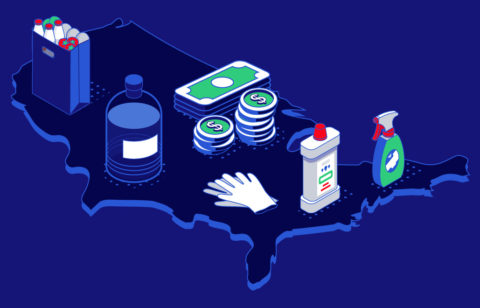If you are American, the chances of you being guilty of overspending is quite high. Considering what we went through in the past couple of years, it is apparent that the spending habit of the average consumer has to change.
The thing about our society is that we are encouraged to spend – or more accurately, to spend excessively. In an economy that is 70% reliant on consumer spending, you will realize that everyone and everything around you will be campaigning for you to make purchases. If you think about it, our spending is probably what got us into trouble back in 2007.
Before we can really define how we can ditch the spending habit of Americans, you may want to understand how we spend in the first place.
How does the average American consumer spend?
An article published on Adage.com in 2006 revealed some pre-recession statistics that showed how the American spending habit makes us the biggest spenders in the planet. Apparently, what we spend in a week is more than the annual GDP (gross domestic product) in Finland. In fact, the average spending of the American household is at $1,500 a week – and this was back in 2006! Although the majority of the spending is done food, transportation, clothing and housing, which are basic necessities, they were done in excess. We needed a home, that is true, but not two of them. We needed clothes but not those expensive designer clothes. We need to eat but we do not have to dine out all of the time.
The mentality of the excessive spending habit is deep rooted in our society that it seems quite hard to get rid of. The American spending habits can be destructive and we have already proven that when the recession triggered a lot of financial disasters in household. We can probably agree that things would not be too bad if only we didn’t have all the debt caused by our excessive spending. If we had savings instead of debt, it would have been easier to recover.
If you analyze the average consumer spending habit and compare it to different countries, you will realize just how different our priorities are. The Bureau of Labor Statistics released a comparative study that shed some light on the spending trends in 4 countries back in 2009. These countries included the United States, Japan, United Kingdom and Canada.
According to the data published on BLS.gov, the priority spending in these 4 nations are as follows:
United States:
-
Housing: 26.3% (does not include mortgage interest, principal payments and property taxes)
-
Transportation: 17.5% (6.3% public transportation; 34.9% automobile purchase)
-
Food: 14.6% (41.1% outside the home)
-
Health: 7.2% (more out of pocket share in expenses)
-
Clothing: 4%
Canada:
-
Housing: 21.4% (does not include mortgage interest, principal payments and property taxes)
-
Transportation: 20.6%
-
Food: 15.3%
-
Clothing: 6%
-
Health: 4.2% (lower because of national health care options)
United Kingdom:
-
Housing: 24.1% (does not include mortgage interest, principal payments and property taxes)
-
Food: 19.9%
-
Transportation: 15.2%
-
Clothing: 5.5%
-
Health: 1.4% (lower because of national health care options)
Japan:
-
Food: 21.8% (21.4% outside the home)
-
Housing: 21.6% (includes rent, utilities and communication)
-
Transportation: 9.8% (public transportation is preferred; 23.8% public transportation; 22% automobile purchase)
-
Health: 4.3% (lower because of national health care options)
-
Clothing: 4.2%
In ranking the basic necessity spending habit of each country, most of them spend more on housing costs. That is probably due to the fact that the average home expenses are really among the highest that people will spend on. In terms of food, it is evident that Americans spend unnecessarily on dining out. This is something that we can all cut back on. Not only that, our preference to transportation expenses may be something that we can change too. With the rising prices of gas, we should be more encouraged to seek out ways to lower our car expenses. Biking or carpooling are only some of the ways that we can really lower our monthly expenses.
Tips to help you change the consumerist shopping habit
Changing our spending habit is something that will take more than just lowering our budget. It has to involve certain changes in our mindset and some activities too.
Bloomberg.com revealed in an article last January 2014 that consumer spending rose in the fourth quarter of 2013 – by 3.2%. The household spending rose to 3.3% and it is noted to be the best since 2010. Despite that fact that the government shutdown and the debt ceiling issues were prominent in October, it did not hinder American consumers from satisfying their purchasing needs.
It seems that a looming financial problem in the nation will not deter consumers from making purchases. The strength of the spending of Americans seem to be rising once more and economists are viewing this as a good sign.
But consumers should not view it similarly. More spending would mean lesser savings. While it can help our economy, you have to make sure that your are not implementing any of the bad spending habits that got us in trouble in the past. If you find yourself leaning towards overspending, here are some things that you may want to do.
-
Put yourself on a debt diet. If you have to buy something, make sure it is not on credit. You can use your credit card if you want to maintain your credit score but make sure that you can pay for that expense in full when the billing comes in. If you cannot afford to purchase something without credit, just don’t buy it.
-
Shop with a list. This does will never get old. Making a list will help you plan and budget any shopping errand. It will lower the chances of you overspending – at least if you stick to your list.
-
Avoid catalogs. These are just temptations that will get you to spend your money. If you do not need more clothes, then just don’t buy more.
-
Exchange the old with the new. If you feel like you need to buy new clothes, look at your wardrobe and select one or two items that you can let go of. If you cannot choose, then you should keep yourself from buying new stuff. You are not only forcing yourself to make smarter spending decisions, you are also minimizing the clutter in your home.
-
Do the waiting game. If you think that you need to buy something that is not included in your plans, you may want to go on a waiting game. Do not give in to the impulse buying urge. Wait for a week before you buy it. You can make it a month or even just a day. If you really need that product, the urge to buy it will not diminish. That is when you should realize that it is not a fad.
-
Budget your online spending. Most of the time, you use your credit card to make online purchases. This is actually encouraged because of the extra layer of protection that it can provide – at least compared to debit cards. But using cards will make it more difficult to limit your spending. Make sure you budget it so you will not end up overspending.
The spending habit of the American consumer is not totally lost. We may be viewed as the biggest spenders in the world but that does not mean we cannot change that. It takes some getting used to but you have to start making smart choices about your money. That is how we can try to avoid another financial catastrophe.
In case you have put yourself in debt because of overspending, here is a video from National Debt Relief that can give you tips on how to achieve debt freedom.





